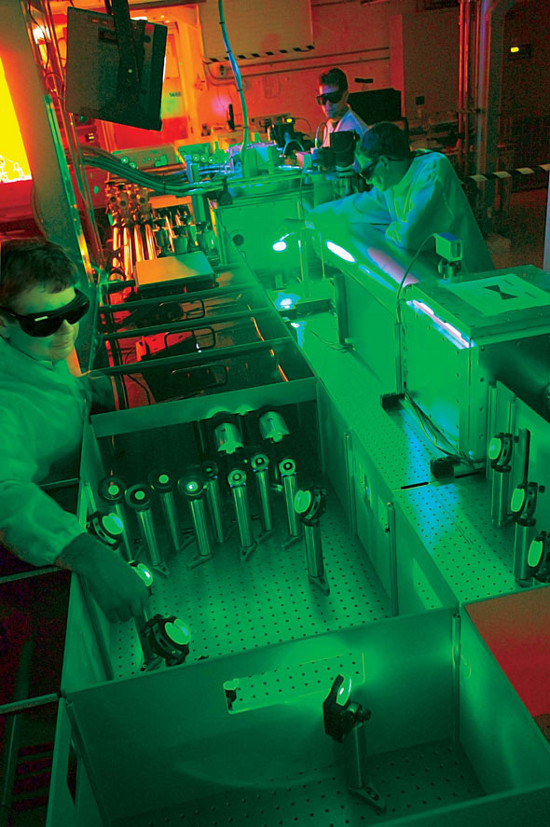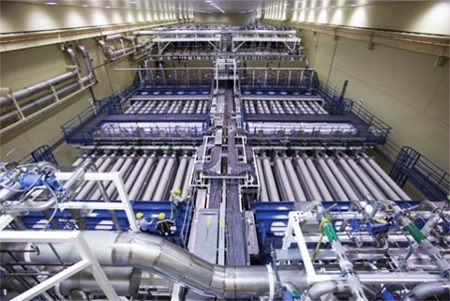Director's Corner
8 July 2010
 Barry Barish |
The laser and the next 50 years
In my column last week on the 50th anniversary of the demonstration of the first working laser at Hughes Research Laboratory in 1960, I stressed the remarkable impacts this fundamental physics discovery has had both in developing a multibillion-dollar industry and in affecting the way we live. Today, I continue that theme by projecting a little on what we can expect from further laser developments in the next fifty years. Of course, undoubtedly, some of the most important future developments have not even been thought of yet. Nevertheless, it is clear that the new laser developments will continue to have an impact on our lives in new and exciting ways, both by opening up new scientific opportunities and in creating new applications to our everyday lives.
 The laser used to accelerate electrons by plasma-wakefield acceleration to one billion electron volts in only three centimetres. (From Symmetry Magazine October 2009 – Image: Roy Kaltschmidt, Lawrence Berkeley National Laboratory) The laser used to accelerate electrons by plasma-wakefield acceleration to one billion electron volts in only three centimetres. (From Symmetry Magazine October 2009 – Image: Roy Kaltschmidt, Lawrence Berkeley National Laboratory) |
As laser science develops, so will it enable major new science opportunities. The International Linear Collider relies on lasers to produce the electron beam that is accelerated in the machine. The next big step in particle accelerators will be to actually develop research accelerators that use lasers for the acceleration of the particles. Although these ideas have been around for some time, recent successes have motivated new ambitious R&D efforts that are getting underway. At the Lawrence Berkeley Laboratory, a Laser Accelerator demonstration (BELLA) was a recipient of US American Recovery and Reinvestment Act stimulus funding. There are also significant efforts in laser acceleration development in the UK, France and beginning in China. This support and the continuing development of laser capabilities is giving a substantial boost to developing compact synchronised laser systems to accelerate particles to high energies. Although it is still some time away, actual compact laser particle accelerators can be envisioned in our future.
I have been serving on the Scientific Advisory Committee of what is perhaps the most ambitious project based on pursuing science through advancements in laser technology. The European Extreme Light Infrastructure(ELI) initiative will make a huge step of developing a facility with an increase of laser intensity of a factor of a thousand. The Scientific Advisory Committee produced an informative report last year on the potential of ELI science. This facility will pursue broad scientific goals in three major areas of science: attosecond science (one attosecond equals 10-18 seconds or a billionth of a billionth of seconds), high-field science and high-energy beam facilities. In a very interesting development, the siting competition for the ELI infrastructure was decided last year when it was agreed to spread the infrastructure among three or four countries, with the Czech Republic, Hungary and Romania already decided. These will be the first three, the final location will be decided in 2012 and this very large investment in scientific infrastructure in Eastern Europe will be coordinated though a central management.
I have concentrated above on some of the future impacts on science as laser technology develops. I will finish today's column by anticipating some ways future laser development will change our lives.
For medicine, one of the most important developments is that lasers will more and more become a crucial tool for various types of delicate brain operations. Laser eye surgery will almost entirely replace the need for eyeglasses or contact lenses. Reshaping the cornea with laser light to correct for myopia is by now a well-established procedure. In the future, we can anticipate using lasers to reshape the human eye, first by using a laser beam to find the problem and make precision measurements that will be analysed in a computer giving information to then be used for a second laser that has been programmed to make the corrections.
Lasers could help provide new sources of energy. The National Ignition Facility (NIF) at Lawrence Livermore Laboratory is an ambitious demonstration device that uses 192 powerful lasers to heat and compress a small amount of hydrogen fuel to the point where nuclear fusion reactions take place. NIF has recently begun its experimental programme and it has the goal of achieving "ignition", where it will produce more energy than was used to start the reaction.
Finally, lasers will continue to change how we work. The next revolution in computers will possibly be the development of optical computers. Lasers are already used with the computer to read, write and record data, but in the future lasers may replace the wires, connections, circuits, etc making even smaller and faster computers. Of course, the same advances will increase the power and reduce the size of today's handheld devices, where it is hard to imagine all the applications we will have at our fingertips.
One emerging technology that is beginning to receive lots of publicity is 3-D television, where early products are already appearing. In the future, one can easily imagine laser-computer advances that will lead to practical three-dimensional holographic movies that can be watched without special glasses. Holographic television will likely follow, but so much information is required to form the holographic images that it will require greatly increased bandwidth into the home before this can be realised.
The laser is the modern poster-child for the indisputable value of fundamental research. No one had any idea of the impact the laser would have 50 years ago when it was first demonstrated by Maiman at the Hughes Research Laboratory. Now, the laser is one of our most important high-tech economic drivers, it is enabling new generations of science, and it is providing new tools for medicine and maybe even new energy sources. And, as if that were not enough, the laser is continuing to change our everyday lives in ways that are hardly recognisable.
-- Barry Barish

